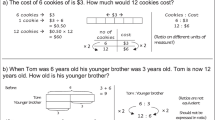Abstract
This article discusses the design of tasks for teacher education. It focuses on tasks that are used in a university course for pre-service secondary school mathematics teachers. Special attention is given to tasks that use analogical thinking in their construction or implementation. These tasks are categorized by type of teacher education goal and analyzed with respect to the use of analogical thinking. Short examples are presented for three of the goal categories, while an elaborated example is given for the fourth one. The detailed example describes the goals and design of a task sequence following an emergent pedagogical need. Using the ad hoc constructed task-sequence the teacher educator avoids “telling” while demonstrating an alternative instructional approach, and seizing the opportunity to bring up additional pedagogical issues.

Similar content being viewed by others
References
Ball, D. L. (2000). Bridging practices: Interwining content and pedagogy in teaching and learning to teach. Journal of Teacher Education, 51(3), 241–247.
Boaler, J. (2003). Studying and capturing the complexity of practice: The case of ‘dance of agency’. Proceedings of the 27th International Conference for the Psychology of Mathematics Education, 1, 3–16.
Cobb, P., Yackel, E., & Wood, T. (1992). A constructivist alternative to the representational view of mind in mathematics education. Journal for Research in Mathematics Education, 23(1), 2–33.
De Bock, D., Verschaffel, L., & Janssens, D. (1998). The predominance of the linear model in secondary school students’ solutions of word problems involving length and area of similar plane figures. Educational Studies in Mathematics, 35, 65–83.
English L. D. (Ed.) (1997). Mathematical reasoning: Analogies, metaphors, and images. Hillsdale, NJ: Lawrence Erlbaum Associates.
Hallel, E., & Peled, I. (2001). Composing analogical word problems to promote structure analysis in solving algebra word problems. Proceedings of the 25th International Conference for the Psychology of Mathematics Education, 3, 105–112.
Hiebert, J., & Carpenter, T. P. (1992). Learning and teaching with understanding. In D. A. Grouws (Ed.), Handbook of research on mathematics teaching and learning (pp. 65–97). New York, NY: Macmillan.
Jaworski, B. (1994). Investigating mathematics teaching: A constructivist enquiry. London: The Falmer Press.
Lampert, M. (1990). When the problem is not the question and the solution is not the answer: Mathematical knowing and teaching. American Educational Research Journal, 27(1), 29–63.
Ma, L. (1999). Knowing and teaching elementary mathematics. Mahwah, NJ: Lawrence Erlbaum Associates.
Mason, J. (1998). Enabling teachers to be real teachers: Necessary levels of awareness and structure of attention. Journal of Mathematics Teacher Education, 1(3), 243–267.
Meron R., & Peled, I. (2004). Situated or abstract: The effect of context and structure in constructing an additive schema. Proceedings of the 28th International Conference for the Psychology of Mathematics Education, 4, 1–8.
Peled, I., Meron, R., Rota, S. (2007). Using a multiplicative approach to construct decimal structure. Proceedings of the 31st International Conference for the Psychology of Mathematics Education, 4, 65–72.
Peled, I., & Segalis, B. (2005). It’s not too late to conceptualize: Constructing a general subtraction schema by abstracting and connecting procedures. Mathematical Thinking & Learning, 7(3), 207–230.
Reed, S. K. (1987). A structure-mapping model for word problems. Journal of Experimental Psychology: Learning, Memory, and Cognition, 13(1), 124–139.
Shulman, L. S. (1986). Those who understand: Knowledge growth in teaching. Educational Researcher, 15(2), 4–14.
Zaslavsky, O., & Leikin, R. (2004). Professional development of mathematics teacher educators: Growth through practice. Journal of Mathematics Teacher Education, 7(1), 5–32.
Author information
Authors and Affiliations
Corresponding author
Rights and permissions
About this article
Cite this article
Peled, I. The role of analogical thinking in designing tasks for mathematics teacher education: An example of a pedagogical ad hoc task. J Math Teacher Educ 10, 369–379 (2007). https://doi.org/10.1007/s10857-007-9048-6
Published:
Issue Date:
DOI: https://doi.org/10.1007/s10857-007-9048-6




